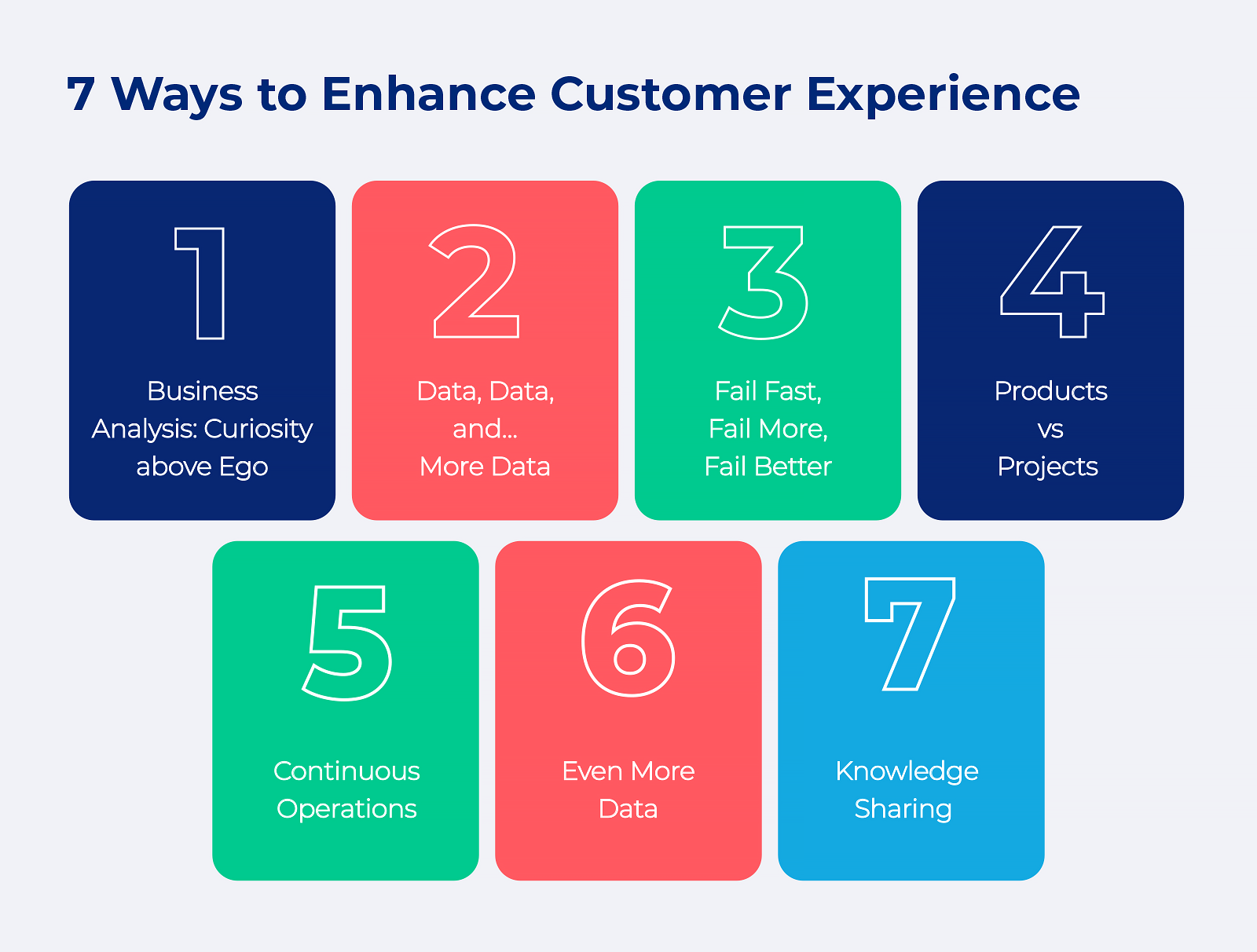Customer experience is paramount for product development, so no wonder businesses’ focus never shifts too far away from the user-centric design. This means they continuously utilize user feedback to improve the whole range of software applications and their functionalities.

Intuitive software is at the core of user-centric design. It is key to meeting consumers’ needs and staying relevant in the long run, as easy-to-use apps provide a flawless user experience that will increase customer loyalty and satisfaction.

1. BA: Curiosity above ego
Many solution providers offer silver bullets for a variety of problems. All too often, decisions are made too early in the process of analyzing the functionality of a prospective product. However, at this stage, there is not enough understanding about the actual application IRL yet. This would inevitably affect the structure, technological choices, and other details of the solution.
This is where BA enters the picture. It defines the requirements the product is expected to meet, identifying various user groups, and selecting suitable testers to examine each software functionality. Personalized testing plans for each user need to include different scenarios and clear instructions for the testers.
It is also up to the Business Analyst to collaborate with developers to plan, analyze data and proceed with the testing phase. You have to do this early enough to incorporate potential customers’ feedback into the application.
This is one of the reasons to develop software in short Sprints when working under Agile methods such as Scrum.
2. Data, data, and… more data
Speaking about data – even for prospective products that haven’t yet accumulated data from real customers, data is present in various forms in social media, websites, mobile applications, marketing platforms, CRM systems, etc.
Data experts can use data from other processes to optimize the user experience and user interface.
This way, websites and mobile apps will ultimately provide enhanced customer journeys. Such an approach leads to the automation of marketing techniques to boost consumer attrition and improve activation, retention, and acquisition.
User research and commitment are instrumental in creating impeccable User Experience. That is why, customer experience management needs to incorporate data-driven strategies and analytics in order to keep the experience exciting.
The data-driven approach facilitates building easy-to-navigate applications with a tasty look and feel. Naturally, these apps will be more likely to attract users to return and recommend them to their acquaintances.
3. Fail fast, fail more, fail better
The trial and error method is at the very heart of the iterative process. Finetuning and improving a product is only possible with quality feedback and information updates, so customer involvement in iterative design and development is pivotal. Of course, to have meaningful testing, teams need to invest enough time and effort in planning and analysis before implementing the first iterations.
New features, bug fixes, and A/B tests are all instrumental in the testing phase of the iterative process. However, it is not sufficient to come up with different iterations. What truly matters is testing them with a group of potential customers and studying their pros and cons to select the ultimate version.
Besides usability testing with probable users, it is essential to gather stakeholders’ feedback before evaluating and reviewing the tested versions and aligning further improvements. Depending on the level of achievement of projected deliverables, you can restart the iterative process if the results are deemed unsatisfactory.
4. Products and projects are different animals
Even the common naming of roles in projects and products show the glaring difference in how they should be handled differently. And yet, it is a common mistake to confuse the two.
Projects are managed, and products are owned. Software projects include all the phases of development before their completion. Once the enterprise that has assigned the project is pleased with the development process, the software or service is manufactured and becomes a product after its market launch.
While products answer specific needs that have been recognized, projects define the way to execute ideas.
Schedules, budgets, and teams are outlined in the project scope. The focus is on execution, while the products’ main goal is creating a sustainable environment.
Therefore, products are long-term and require updates, upgrades, fixes, new versions, etc. The more temporary nature of projects, fixed time frames, and milestones explain their relative predictability.
To cut a long story short, treating products and projects interchangeably does harm in both cases. Composers do not treat writing a 3-minute hit song and a symphony the same way.
Products are more about the journey than the end goal, and it is not unusual to change for the better or worse. Just make sure you have the flexibility to react depending on the situation.
5. Morpheus was wrong
“Everything that has a beginning… has an end, Neo.” Said Morpheus. And, although in the global scheme of things, of course, he is right, when thinking about a product, there should be no “end” in the way it is treated.

Continuous operations, feedback loop, and improvement guarantee operational consistency, customer satisfaction, and maximum service at minimum cost.
Only uninterrupted operations of apps and data services ensure new releases and updates meet quality standards and criteria. This means infrastructure, applications, and services need to be constantly monitored and repaired whenever necessary. Flawless automation architecture and services orchestration are pivotal to achieving end-to-end automation and avoiding accidents.
Selecting suitable automation platforms facilitates the integration of tools to fully automate and monitor end-to-end processes.
Scalefocus has a dedicated AppCare 360 support and maintenance center with established DevOps culture and cloud-native development methodology.
This service enables our experts to seamlessly deliver Continuous Operations and enhance our partners’ capacity while operating without interruption.
6. Data, data, and… you already know what
Operational data can be even more valuable than the initial set utilized for designing the product itself.
Once real customers start doing real things with a product, the data it produces automatically becomes valuable. In fact, it matters much more than anything else that was present before (during the design phase of product development).
Utilizing this data to improve the product constantly is often the differentiator between a product that becomes a valuable everyday tool for your customers and a one-time problem solver.
7. Cross-domain knowledge sharing breeds innovation
Internal knowledge sharing can benefit customers enormously in order to solve problems in ways common for domains other than theirs, but modern and innovative, nonetheless.
Naturally, it gives access to a broader range of expertise and experience. When experts from different domains share their knowledge and experiences, they are more likely to find new and unexpected solutions to existing problems.
Internal knowledge sharing can also contribute to creating a culture of thinking outside the box, searching for unorthodox solutions, and continuous learning within an organization. Sharing knowledge and expertise helps employees to keep track of the latest trends in their respective fields, optimize business processes, and improve customer experience (CX). Ultimately, both employees and customers will benefit significantly from innovation, originality, and a wider range of products and services.
UX and UI Design at Scalefocus
At Scalefocus, we leverage cutting-edge technology to ensure we go the extra mile to address our partners’ pain points and meet customer expectations.
We base micro-performant frontends on the latest trends to leverage customer-driven metrics and highly performant architectures.
Our experience in research, conceptualizing, prototyping, testing, and iteration proves pivotal for ensuring the entire product cycle continuity. We deliver high-fidelity designs, product identity, UI interaction, and expected behavior before development begins to provide an exciting product preview.
Scalefocus teams use the discovery and research phase of the product development lifecycle to define user and business needs and goals. The methods we apply include workshops, stakeholder and user interviews, focus groups, UX evaluation, and surveys to define user and business needs and goals.
Building a strategy is also a pivotal phase. Our teams utilize the accumulated data as a platform to create user personas, user journeys, and low-fi prototypes and validate them with the stakeholders and the users.
After the validation, it is time for the actual UI design and high-fi prototype.
All the way between product concept and launch, our teams perform continuous testing and hypothesis validation to ensure that your product is viable. The iterative cycle is indispensable to validate the initial hypothesis, identify the next steps of the iterative cycle, and deliver improved product versions.
Conclusion
Business analysis, quality data, continuous operations, and internal knowledge sharing are among the critical factors for improving user experience. Customer-centric iterative development and handling products and projects differently are also instrumental to the product development process.
Scalefocus’ development teams of seasoned experts leverage a wide range of techniques to gather data from stakeholders and different user personas to provide a world-class product experience.
Do not hesitate to contact us and discuss how your business can leverage our expertise to achieve the level of UX and UI that will take your products to the next level!



